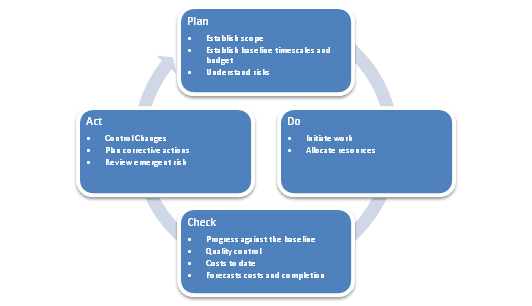There are three main sections to a Project Management Framework, which are designed to help the project manager complete a project successfully. The first of these is what we fundamentally understand as project management, and this along with the other two parts are described below. But if you have a good project management environment why do you also need a framework? Here are some key reasons why a framework can make your project management environment even more successful:
- Aids the development and use of best practices.
- Ensures a common language is used for communication within the project team.
- Simplifies the fundamental project management procedures.
- Helps clients understand the project management processes.
- Maintains focus while getting a project off the ground.
1. Project Lifecycle
This part of the project management framework is a guide to the basic stages that are present in all projects. These basic stages may vary from company to company and from project to project but their underlying aim is the same, even in projects when certain stages may be omitted. For instance, not all projects will involve tendering and contract negotiation if they are being completed in-house.
The basic stages are likely to involve:
Project Development – the decision to pursue a project
Tendering – preparing and submitting a bid
Contract Negotiation – accepting the contract
Project Mobilisation – Initiation, scope, budget, schedule and risks
Project Implementation – completion of tasks, reviews & reporting, testing, client acceptance
Project Close – formal closure, review of lessons learned
2. Project Control Cycle
The project lifecycle is concerned with tasks that need to be completed whereas the project control cycle concentrates on how each stage is planned and managed. The project control cycle effectively provides a means of navigation through the roadmap that is the project lifecycle. It is based on a straightforward cyclical process of: PLANNING, DOING, CHECKING, ACTING to ensure each stage has relevant controls in place and planned corrective actions, as necessary.
The PLANNING phase establishes the scope, timescale and budget of the project, as well as forming an understanding of the associated risks.
The DOING phase allocates resources and starts the work of the project.
The CHECKING phase compares progress against the schedule, performs quality control and assesses cost to date and costs to completion.
The ACTING phase reviews any risks that are becoming apparent and instigates corrective action, as well as controlling requested changes.
3. Template and Tools
Project management for any size or complexity of project requires tools and templates to make the processes easier to complete and understand. This is true regardless of the particualr PM approach you might be taking: a knowledge-based approach such as APM PFQ, APM PMQ or PMP, or a structured approach such as PRINCE2. Standard templates aid the understanding of all those involved by using a common, consistent means of communication throughout the project. However, the tools and templates used must be appropriate to the size and complexity of the project. Clearly a small, simple project using an in-house team will require a few minimal tools and templates but a large complex project would require something quite different. So there are no “one size fits all” solution.


This page isn’t opening properly, not sure which device it was built for? I’m using my laptop, Chrome
Pingback: Herding Cats, Enterprise Social and Other Content of the Week
Anne
Try now
Hi Michelle, great article and I totally agree with your points. I think that it’s is also worth a little emphasis the other important element that successful projects need, i.e. capable & competent project managers, sponsors and the right team. Only they will be able to make use of the framework for maximum effect.
Thanks again!
Pingback: Atidan Offers Free Project Management Template for Microsoft SharePoint | construction-project.us
Thanks, this content very informative. yes, without proper project planning and framework any project cannot be a successful.
http://www.gwains.com